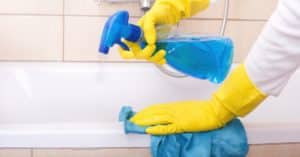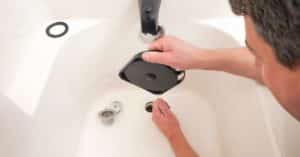Tub Cleaner Continues to Clean After
Nothing beats a good, relaxing dip in a warm bath to wash away the worries of the day unless your bathtub is the source of your stress! Bathtubs are notorious for attracting dirt and grime, mold, and filth, as well as lasting stains created by hard water and rust.
It might be appealing to use harsh or toxic cleaning solutions that claim to rapidly eliminate all filth and grime, but you should think about the safer alternatives before using harsh chemicals that aren't necessary for the task.
There are no two bathtubs alike. How you clean your tub must depend on its material. A fiberglass tub, for example, will require different cleaning procedures than a ceramic or coated stainless steel tub. Luckily, you'll have a fairly consistent cleaning procedure across the board if you learn which cleaning equipment and chemicals work best for particular surfaces. Continue reading to discover the basic procedure in bathtub cleaning, along with other particular cleaning techniques for different kinds of tubs.
Simple Steps to Clean a Bathtub
Step 1: Tidy up the bathtub.
It will be difficult to clean your bathtub ledge if it is cluttered with products and accessories. Minimize your bath goods by selecting just what you needed and keeping the rest until you use them. Put these few essentials in a tight area or hang them from a showerhead shelf. This will help keep the gooey substance left by leaky caps and pumps off the tub's sides.
Step 2: Give it a rinse.
Rinse your tub well using hot water to moisten it and remove any visible debris or filth, then flush it into the drain.
Step 3: Put baking soda.
Sprinkle baking soda generously in the bathtub, and also in the drain and faucet hardware. If your tub is very filthy, use a tub-and-tile cleaner from the market instead of baking soda and follow the product's cleaning guidelines.
Step 4: Make a soapy water combination.
Pour the bucket halfway with lukewarm water and add a few drops of mild yet excellent dish soap.
Step 5: Scrub the tub.
Grab a scrub brush or a sponge and give your bathtub a whole sponge or scrub bath using the soapy water combination depending on how unclean your tub is. Refill the soapy water combination on your cleaning bucket as needed, and be careful to rinse it off repeatedly in the pail.
If the tub is very filthy, you may immediately put baking soda over the sponge or brush then wash it with some good vigorous cleaning. The soapy water will mix with the baking soda and form a sticky paste that will work its magic.
Step 6: Rinse the tub thoroughly.
It is essential not to brush the filth and soap scum away just to have it stiffen again in the tub. Alternatively, keep filling the bucket and pouring it into the tub to wash it out whenever you clean.
Step 7: Do not forget to Sanitize
Disinfect your tub and surrounding areas using a spray bottle filled with a homemade diluted bleach mixture or a ready-made solution to get rid of any mold or leftover germs. Open all windows and turn on some fans to ensure that your bathroom is thoroughly aired during this phase!

Step 8: Polish it up
The tub isn't the only thing that has to be cleaned. Polish the faucet as well as the handles, and the area surrounding the drain to complete the job. Use a clean cloth and a small amount of whatever cleaning solutions you used to clear out the tub for this. To make them sparkle, dry them.
Go for Natural Cleaners
Chemical cleaning products are efficient, but they're not the only choice for cleaning your tub. To complete the task, you can make use of a natural tub and tile cleaner. Natural tub and tile cleaners come in a variety of alternatives, so selecting one that meets your needs will not be challenging. Using environmentally friendly cleansers keeps hazardous chemicals out from the sewer tanks and reduces pollution from our sources of water. Also, there are biodegradable, environmentally friendly dish soaps available for use in both the bathroom and the kitchen. A mixture of vinegar and baking soda also works well as an all-purpose cleaner.

Ways to Clean Different Bathtub Materials
Porcelain Enameled Steel
When it comes to bathtubs, porcelain-enameled steel is a popular and very affordable alternative. Bathtubs made of this material are often heavier than those made of acrylic or fiberglass. They are exceptionally long-lasting and simple to clean. One of the downsides of utilizing a porcelain enameled steel bathtub is that it is easy to chip it, and the chipped areas can corrode fast.
How to Clean it?
Harsh cleaners should not be used to clean a porcelain bathtub because they can damage the surface. Scrubbing white vinegar and steel wool should also be avoided since they might harm the bathtub's finish. You may use any of the bathtub cleansers available in the shop if you want a cleaner that is mild on the exterior and can be used weekly. Make sure the product you're using is safe for porcelain enamel.
Following the procedures below, you may produce your homemade porcelain bathtub cleaning at home:
- Using a sponge or rag, put a couple of teaspoons of dishwashing liquid into a gallon of hot water and scrub the bathtub's surface.
- Wash the porcelain and thoroughly rinse it.
- Be sure to only use this method once a month, at the most, to avoid damaging the bathtub. If you want to bring your bathtub a fresh and shining appearance, massage the sides with a tiny amount of lemon oil.
Acrylic Material
Acrylic bathtubs are trendy nowadays because of their adaptability, durability, variety of materials, and price. An acrylic tub is constructed from vacuum-formed acrylic sheets that are bonded with fiberglass. They do have a non-porous surface that may be restored to a certain extent if damaged. They're available in a variety of hues, forms, and sizes.
However, caution should be exercised when cleaning these bathtubs because they are prone to scratching whenever cleaned with a harsh solution.
How to Clean it?
If your bathtub is composed of acrylic plastic, you must be particularly cautious when cleaning it. Chemicals and harsh materials may cause a lot of harm to acrylic plastic. As a result, more caution should be exercised when maintaining your acrylic plastic bathtub. Here are some options:
- Before you start cleaning the bathtub, fill it with warm water and soak it.
- Using a moist rag or piece of cloth, massage the bathtub's surface in circles with a tiny bit of baby shampoo.
- Rinse the rag frequently since soap might build upon it. Rinse the bathtub's surface and continue the cycle until you believe it's really clean and clear of spots.
- After the area has dried and been cleaned, add a coat of automotive wax to the bathtub's surface using a rag. Apply the wax to the bathtub's surface in circles, similar to how you'd apply auto wax to your car.
- Wait a few minutes for the area to dry before buffing the bathtub's surface with a clean cotton ball.
The bathtub's car wax prevents soaps, water, and hair products from sticking to the surface. If required, repeat the procedure.
Fiberglass
Fiberglass tubs are also a cost-effective choice for bathtubs. But they are less long-lasting. When cleaning your fiberglass bathtub, be cautious since it is not as strong as other materials and the exterior can quickly break and scratch. With continued usage, the finish begins to degrade.
How to Clean it?
Cleaning a fiberglass bathtub using a shower or cleaning combination is easy if you follow the procedures below:
- Combine a fair quantity of baking soda as well as half a cup of dish soap in a cup of hot water.
- When the ingredients are combined, a paste will develop.
- Continue to add baking soda into the solution until it sticks to the bathtub wall.
- Apply the mixture to the bathtub with a sponge and let it sit for about 30 minutes at least.
- Wait half an hour before thoroughly scrubbing the bathtub.
- Rinse the fiberglass tub with cold water and a paper towel to remove any excess water.
- You may now apply a magic eraser and remove all of the stains and debris.
Use a top-grade rubbing wax formulated specifically for fiberglass to provide the fiberglass bathtub the sheen and look of a new bathtub. Here's what you should do:
- Take an orbital buffer and an excellent quality auto wax.
- Put the rubbing wax in smaller bits and do your magic.
- If you leave the mixture on one spot for too long, it will burn your fiberglass.
- Buff the rubbing wax using a terry cloth before applying auto wax to finish the job.
- Spray with cold water to solidify the shine and make it last longer.
Enameled Cast Iron
Enameled cast iron tub is a bathtub composed of a material that is exceptionally sturdy and hefty. It's composed of molded iron and has an enamel finish. When compared to other types of bathtubs, it is more expensive, but this adds to its durability and longevity.
The strong enamel finish resists chipping and scratches, allowing you to keep the appearance for years to come. To maintain your enameled cast iron tub looking new for years, avoid using dangerous chemicals instead use baking soda and water.
How to Clean it?
Treat your enameled cast iron bathtub with care since using toxic chemicals might cause it to discolor. Baking soda and warm water are highly suggested for daily cleaning. All you have to do now is:
- Apply a paste made of warm water with baking soda to the spots.
- Allow the paste to settle for about 30 minutes.
- Scrub the muck and grime with a cleaning cloth.
- Rinse well with warm water.
Whenever the bathtub has stubborn stains, however, take these steps:
- Add a small amount of trisodium phosphate cleaner (TSP) to a cup of hot water and stir.
- Put the solution to the stain with a sponge and gently massage it in. Rinse well.
Cast Polymers
These are designed natural stone or hard surface elements that are formed along with minerals, polymeric components, and resins to make a solid surface that is generally completed with a gel cast finish. Cast polymer bathtubs should be cleaned with caution since even little scratches can degrade the bathtub's appearance. It is thus strongly advised against using abrasive cleaners or chemicals on it.
How to Clean it?
It is vital to follow correct cleaning procedures when cleaning a cast polymer since even the tiniest scratches will be apparent. Abrasive cleansers and scratchy sponges should be avoided at all costs. To keep safe, follow the procedures below:
- Cleaning should be done with a gentle detergent or soap.
- To get rid of soap scrums, combine equal parts vinegar and water and spray the afflicted area.
- With a soft cloth, wipe the affected area.
How to Clean Bathtub Drain
Flush the bathtub sink drain with boiling water at least once a week. This can aid in the prevention of clog-causing accumulation on the inside of pipes. Alternatively, put a cup of vinegar into the drain and wait 30 minutes. Rinse twice with two gallons of boiling water.
Pouring an enzyme drain cleaner down the bathroom drain once a month can also help prevent blockages from accumulating. These cleaners contain enzymes that help dissolve the buildup and keep drains clean. Rinse with cold water before using the tub again. This solidifies any leftover dirt, making it easier to pass down drain lines.

How to Unclog Bathtub Drain
You rise from your bed and proceed to the bathroom. You're prepared to start the day with a nice shower. However, as you are shampooing your hair, you notice that the water is slowly creeping around your ankles. You must unclog your bathtub drain for your next shower!
Chemical drain cleaners may be the first thing that comes to mind, but they are a dangerous technique to unclog drains for several reasons. For starters, using strong chemicals on a regular basis might destroy your pipes and cause problems later. Second, flushing harmful materials down the drain contaminates the water system.
There are a few non-chemical solutions to unclog a bathtub drain.
Eliminate the muck
Begin by detaching the stopper to remove easy-to-reach muck. Insert a screwdriver beneath the lid of your tub's pop-up drain stopper, release the screw, then remove the plug. Body hair as well as other particles may have gathered here when you lift it out. If you're too disgusted to scrape the filth by hand, use needle-nose pliers to shape a wire coat hanger into the hook. Then, using this helpful tool, pull out any foreign stuff from the drain.
Manually pulling and cleaning these bits will sometimes get things rolling. To conclude the task, pour boiling water down the drain. If the tub continues to clog, the obstruction is deeper, and you'll need to attempt alternative home treatments to clear the drain.
Pour Boiling Water
Boil a big bowl of water and flush it down the bathtub drain carefully. The aim is to get rid of the soap scum and the hair accumulation. One cup of baking soda and one cup of vinegar can also help loosen things up.
Utilize a Plunger
With the stopper unfastened, a plunger may be used to empty the drain. To begin, establish a vacuum by plugging the overflow drain. Lift the cover plate underneath the bathtub tap and cover the opening with a towel or hand towel to prevent air from escaping.
Load the bathtub with a few feet of hot water and place the plunger on the drain. To start things flowing, use a series of thrusting actions.
strangewittappona.blogspot.com
Source: https://hellamaid.ca/blog/your-full-guide-on-cleaning-a-bathtub/